4.1 Definitions and terminology
Memorial registers
In the Middle Ages there was no universal terminology for texts that were used in the commemoration of the dead. The documentation of memorial practices in institutions depended on the requirements and practices within each separate institution. Even for institutions that belonged to the same group, such as monasteries of the same order, there were not necessarily fixed rules concerning the administration of memoria. As a result, certain sources that have essentially the same contents and design can be known under different terms. Alternatively, one and the same term can indicate different types of memorial registers (see fig. 1). Local and regional customs are also a factor. An overview with memorial celebrations in calendar form, for example, can be called a necrology (necrologium), a calendar (calendarium) or an anniversarium.
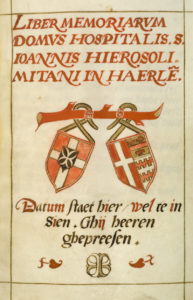
Fig. 1. Liber memoriarum of the convent of St John in Haarlem. This manuscript (1570) is a register of graves which also lists memorial services, see MeMO text carrier ID 187Compare this with a memorial register by the same name from Roermond, MeMO text carrier ID 101
The literature about the sources uses either the term that was found in the manuscript, or terms that became popular only after the Middle Ages. At the beginning of the 1970s, Huyghebaert published a classification (in the series Typologie des sources) to create more unity in the terminology. The following classification is Huyghebaert’s:
1. The registers and other documents to commemorate the dead and the living:
- the earliest memorial registers, dating from the Carolingian era, the Libri Vitae, also known as Libri Memoriales or Libri Confraternitas. These are liturgical sources that are intended to be used during Holy Mass.
2. The registers in which only the dead are registered:
- the lists of dead or mortuary rolls (rotuli) that were distributed among the associated communities, for example monasteries of the same order.
- The necrologies, obituaries, anniversaries, lists of pittances, etc. that were produced from the ninth century onward. These are usually set up as calendars, and can be distinguished as:
- Necrologies, lists of names of the deceased that are noted down in a calendar or martyrology and that were intended to be read aloud on that particular day during the Divine Office, usually the primes. These sources have a liturgical character.
- Obituaries, overviews that remind the community when obligations such as anniversaries and the distribution of alms for the poor, have to be fulfilled.
- Registers of graves, overviews of who is buried where, produced for the purpose of the visits to the graves of the deceased following a memorial Mass.
- Lastly Huyghebaert mentions the necrological annals, compilations of short texts and lists in which, for instance, benefactors or superiors of monasteries and monastic orders are commemorated.
This classification is based on how the sources functioned. It was later supplemented by Lemaître. As Huyghebaert indicated himself, the compilers of this classification were however unable to solve the problem that in many cases the registers are mixtures of the pure types in this classification. A register of memorial services can also contain donations and pittances, for example, or information on graves and burial places.
The classification of memorial registers in MeMO
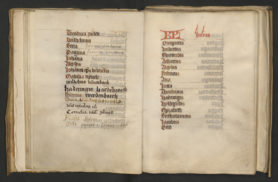
Fig. 2a. Register of names of Oostbroek Abbey near Utrecht (Benedictine nuns), ordered per month, see MeMO text carrier ID 407The name of one Hadewych Hardenbroeck is also featured here, fol. 14v. This may have been the Benedictine nun who is depicted in a painting from Oudwijk Abbey in Utrecht, see fig. 2b
For the descriptions of the memorial registers in the MeMO database a classification was made that is based on the contents of the registers:
- registers of graves, subdivided into
- burial places with the names of those buried (fig. 1)
- registers of owners of graves
- registers of memorial services (see Register of memorial services included in a martyrology of Carthusian Monastery Nieuwlicht: MeMO text carrier ID 429 and fig. 2a)
- registers of gifts and foundations (fig. 3)
- registers of pittances and doles
- registers of names not belonging to the aforementioned groups (fig. 4 and 5)
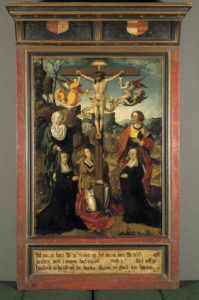
Fig. 2b. Memorial painting with the devotional portraits of nuns Hadewych van Hardenbroeck († 1543) and Agnes van Ghent, kneeling next to the crucified Christ, MeMO memorial object ID 631
This classification is not based on function, but rather on contents (i.e. appearance). The starting point in the classification of the separate memorial registers has therefore always been the primary or prevailing outward appearance of the register. However, the records in the database do provide options of describing variation in the contents. This makes is clear to the user that, for example, a memorial register which was categorised as a register of memorial services, could also mention donations, see fig. 1. The records in the database do however provide options of describing variation in the contents. See 4.4 for the way manuscripts and texts are described.
Narrative sources
For the narrative sources the typology of Narrative Sources (NaSo) has been used, because this online database has served as a prominent source of information for the MeMO database. Narrative Sources itself is based on the Repertorium van verhalende historische bronnen uit de middeleeuwen by Marijke Carasso-Kok. In terms of terminology and set-up the Repertorium and the NaSo-database are both based on the typology of Genicot c.s. (Typologie des Sources). For a discussion of the problems concerning the classification of narrative sources, see: Vanderputten, ‘Typology of Medieval Historiography’ (2001).
Of the many different types of narrative sources, MeMO includes only those that offer information about the commemoration of the dead. This means that there are two main groups:
- biographical sources:
- gesta commemorating the lives and deeds of abbots and other ecclesiastical officials
- biographies, primarily of conventuals, but also of lay persons
- historical sources:
- chronicles (see Chronicle of the Convent of St Barbara in Delft : MeMO text carrier ID 173)
- annals of religious and ecclesiastical institutions (fig. 6)
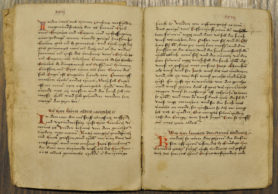
Fig. 3. Register of gifts of the parish church of Velden (ca. 1555), also containing copies of donating charters. The register covers the period 1492-1628, MeMO text carrier ID 427
Of these source types all biographical sources are described, as they all have had or may have had a function in memoria. They contain biographical information about the described persons mentioning for example their virtues, their gifts and foundations, their activities in memorial practices, and counter gifts they received for their gifts or foundations. These texts mainly concern the lives of conventuals written in the houses of the Modern Devotion.
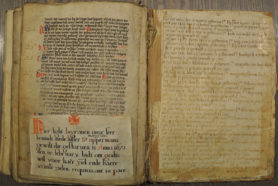
Fig. 4. Register of names listing the prioresses of Maria Weide Abbey in Venlo. Shown is a text that was pasted in for a prioress who died in 1673, MeMO text carrier ID 78
Not all historical sources contain information about the commemoration of the dead, so they had to go through a selection process. The database only contains descriptions of chronicles and annals with a very clear connection to memoria. Examples include information about foundations and donations (including the donation of privileges), about patrons, and about memorial practices and developments in these practices.
Chronicles also have a general remembrance/commemorative function. They may be written to commemorate the origins of a city, a military victory, etc. This is why the MeMO and NaSo databases are complementary tools for researchers who wish to examine memoria and remembrance in a broader context.
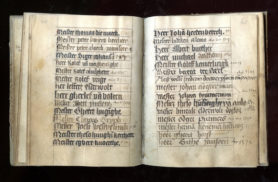
Fig. 5. Memorial register of the Kalendebroederschap in Groningen (ca. 1501-1590), listing both deceased and still living members. The names shown here are those of deceased clerical members of the confraternity, MeMO text carrier ID 436
Overview of the used terminology
In the MeMO database the memorial registers are not organised in the way of Huyghebaert in his Typologie des sources. Nevertheless his terminology and definitions, as well as those of others occur frequently in the MeMO database and accompanying products, for instance in the titles or short descriptions of the registers. The most common terminology and definitions can be found in the overview below.
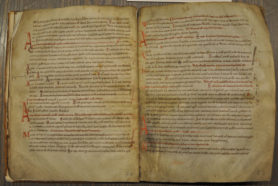
Fig. 6. The Annales Rodenses, the annals of Rolduc Abbey near Rode, f. 7v-8r. The manuscript covers the period 1104-1157 and was written in three phases in the second half of the 12th century, MeMO text carrier ID 207
A few remarks beforehand:
- The many small variations within the terminology are not included. In most cases only the more easily recognisable Latin terms have been chosen.
- Terms used in the manuscripts themselves, or used in the inventories of the holding institutions may not always (completely) match the contents of the texts.
| Term | Explanation |
| General | |
| Book of death (doodboek) | General term, not necessarily contemporary, for various types of memorial registers, see for example MeMO text carrier ID 138 and MeMO text carrier ID 337 |
| Composites | Manuscripts containing texts that were conjoined without necessarily sharing a theme or originating from the same institution. The texts in such a manuscript were usually bound together on the basis of the sizes of the separate parts (texts). There does not need to be any cohesion between the texts in a composite. This type of manuscript was often produced by order of a later owner. See MeMO text carrier ID 19 |
| Convolutes | See Composites |
| Liber memoriarum | Contemporary term for any type of memorial register, used in the manuscript itself. MeMO text carrier ID 187, for instance, is a mixture of a register of graves containing the names of the buried persons, and a register with memorial services (fig. 1) |
| Memorial register |
|
| Miscellany | Manuscript containing multiple texts that show coherence in their themes or contents and/or that originated in the same institution. A miscellany may contain texts that all concern the commemoration of the dead. These manuscripts may have been copied as a whole in one go for the institution where they were used. The texts in the text carrier, for instance a list of graves or a donations register, may have subsequently been kept up to date for a longer period, but it may also have been extended with new texts. See MeMO text carrier ID 17 |
| Register of a chapter (Liber officii capituli) | Manuscript used during the meetings of the chapter of a monastery, containing one or more memorial registers, see MeMO text carrier ID 17 |
| Text carrier | A text carrier may contain one or more texts. If it contains multiple texts, it is important to know how these manuscripts were produced, because this can contribute to knowledge about the functioning of the separate texts. Text carriers containing multiple texts can be roughly subdivided into composites and miscellanies, see relevant entries (but there are all sorts of variations). |
| Verzamelhandschrift | See Miscellany |
|
Memorial registers |
Classification of the memorial registers in the MeMO-database |
| Register of burial places |
|
| Register of gifts and foundations | Registers with descriptions of various types of gifts and foundations, see fig. 3 |
| Register of memorial services | Registers containing information about which memorial services should be performed for whom and when. See: Register of memorial services included in a martyrology of the Carthusian Monastery Nieuwlicht (MeMO text carrier ID 429) |
| Register of names | Register of names not belonging to the aforementioned groups, see fig. 4 |
| Register of pittances and doles | Registers with pittances and doles (usually) with mentions of the names of the donors, recipients, when and where the alms/gifts were to be handed out, and what they were to consist of, MeMO text carrier ID 372 |
|
Memorial registers: other names |
Used in the sources, in inventories and catalogues of archives and libraries, in the classification by Huyghebaert and Lemaître, etc. |
| Anniversarium | See Necrology |
| Calendar | See Necrology |
| Jaargetijdenboek | See Necrology |
| Liber fundationum | Register of foundations or donations |
| Martyrology | Calendar with saints that were to be commemorated. In some cases martyrologies are also used to note the names of to be commemorated persons (who were not saints). See: Register of memorial services included in a martyrology of the Carthusian Monastery Nieuwlicht( MeMO text carrier ID 429) |
| Necrology | Calendar which features a list (sorted per day), of the names of persons who were to be commemorated during Mass. A necrology mainly has a liturgical function. Over the course of time necrologies also came to include information about donations and/or locations of graves. The necrology traces its origins to martyrologies, which were used in the first Christian communities during services to recite the names of the martyrs and of saints in general. See the distinctions made by Huyghebaert discussed previously. |
| Obituary | The obituary is a register in the form of a Roman calendar with the dates of anniversaries and other obligations to be fulfilled in a parish, monastery or chapter. See the distinctions made by Huyghebaert discussed previously. |
| Propijnboek | See Register of pittances and doles |
| Register for the burning of candles (Belichtingsboek) | Register with an overview of how many candles where to be lit for who, when and where (fig. 7)
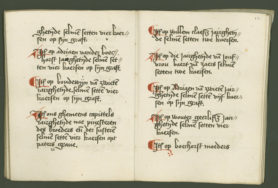 Fig. 7. Register for the burning of candles in the Costerboeck of Mariënpoel convent near Leiden, MeMO text carrier ID 145 |
| Succession list (opvolgingslijst) | A type of chronological register of names of worldly and ecclesiastical dignitaries of a particular office. See MeMO text carrier ID 35. |
|
Narrative sources |
Sources which are described in the MeMO database |
| Annals (annalen) | Overview of events which concerned a particular area, institution or family, etc. sorted by year (fig. 6). |
| Biographical descriptions of clergymen, religious men and women, and laypersons (Bruderbuch/ Schwesterbuch) | These manuscripts mainly concern the lives of male and female conventuals written in the houses of the Modern Devotion, in remembrance of their virtues and special deeds, their gifts to the convent, their activities in memoria practices, counter gifts they received for their foundation, etc. See MeMO text carrier ID 268. Note that in some cases biographies for female members of convents are also included in the manuscript with the biography of the rector. See MeMO text carrier ID 1. |
| Chronicle | Chronicles are narrative overviews of one or more events in the history of for instance a particular area, monastery or family. Included are only chronicles concerning memoria, e.g. reporting on the founding of religious institutions, important gifts and memorial practices, see: Chronicle of the Convent of Barbara in Delft( MeMO text carrier ID 173). |
| Gesta | Gesta are overviews of actions of persons, for instance abbots of monasteries. MeMO text carrier ID 6. |

